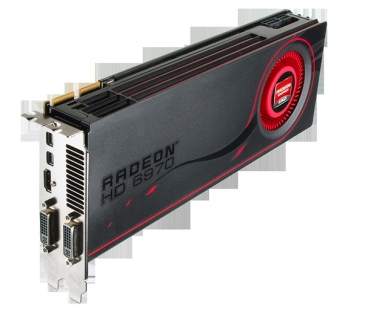AMD has debuted its Radeon 6900 GPU lineup for enthusiast gamers. The new graphics cards boast enhanced second-gen DX11 architecture and are capable of dynamically adjusting power draw on the fly.
The 6970 flagship GPU – which is priced at $370 – features 1,536 stream processors, an 880MHz core clock speed and 2GB of GDDR5 RAM.
Meanwhile, the HD 6950, which weighs in at a $300, offers a slightly lower clock speed of 800MHz, 1,408 stream processors and 2GB of GDDR5 memory.

“Probably the most interesting [addition] to the HD 6900-series of cards is the inclusion of a new technology called PowerTune [which] clamps the GPU TDP to a pre-determined level,” explained Ryan Shrout of PC Perspective.
“By integrating control processors to monitor activity in real time, the GPU has the ability to dynamically adjust the clock rate to enforce a TDP. This gives the driver (and potentially end users) the ability to directly control the GPU power draw via an algorithmic approach to guarantee consistent performance across various products.”
According to Shrout, PowerTune allows AMD to ratchet up GPU clock speeds without having to worry about “outlier” applications that increases power draw to dangerous levels.
“Because of this, in previous generations, AMD has been forced to keep the stock frequencies at a low enough level that even if a user really stresses the design with ‘OCCT SC8,’ they wouldn’t fry their board.
“By constraining those cases, by lowering the clock speeds as TDPs are reached, AMD can set the default clock speed higher for better performance in games without the risk of killing cards,” he added.
So, how does the 6900 series measure up against Nvidia’s GTX 570 and 580?
Well, as Engadget’s Vlad Savov notes, early reviews ostensibly concur that both the Radeon HD 6970 and HD 6950 have “struck a very fine” price-to-performance ratio.
“The 6970 manages to spar with the much pricier GTX 580, but given that it’s priced similarly to NVIDIA’s GTX 570, it scores plaudits for being a more than viable alternative,” writes Savov.
“The HD 6950 is seen as the real value item here, however, particularly since it occupies a relatively unique spot in the price range, and most reviewers tipped it as their new bang-for-the-buck leader.”
Key 6970 specs
- Up to 880MHz Engine Clock
- 2GB GDDR5 Memory
- 1375MHz Memory Clock (5.5 Gbps GDDR5)
- 176 GB/s memory bandwidth (maximum)
- 2.7 TFLOPs Single Precision compute power
- 683 GFLOPs Double Precision compute power
- TeraScale 3 Unified Processing Architecture
- 96 Texture Units
- 128 Z/Stencil ROP Units
- 32 Color ROP Units
- Dual geometry and dual rendering engines
- Scalable geometry processing technology
- Shader Model 5.0
- DirectCompute 11
- Dual advanced programmable hardware tessellation units
- AMD Eyefinity multi-display technology
- Native support for up to 4 simultaneous displays
- Up to 6 displays supported with DisplayPort 1.2 Multi-Stream Transport
- Independent resolutions, refresh rates, color controls, and video overlays.
Key 6950 specs
- Up to 800MHz Engine Clock
- 2GB GDDR5 Memory
- 1250MHz Memory Clock (5.0 Gbps GDDR5)
- 160 GB/s memory bandwidth (maximum)
- 2.25 TFLOPs Single Precision compute power
- 562.5 GFLOPs Double Precision compute power
- TeraScale 3 Unified Processing Architecture
- 1408 Stream Processors
- 88 Texture Units
- 128 Z/Stencil ROP Units
- 32 Color ROP Units
- Scalable geometry processing technology
- Shader Model 5.0
- DirectCompute 11
- Dual advanced programmable hardware tessellation units
- Accelerated multi-threading
- AMD Eyefinity multi-display technology
- Native support for up to 4 simultaneous displays
- Up to 6 displays supported with DisplayPort 1.2 Multi-Stream Transport
- Independent resolutions, refresh rates, color controls, and video overlays.[[AMD]]






